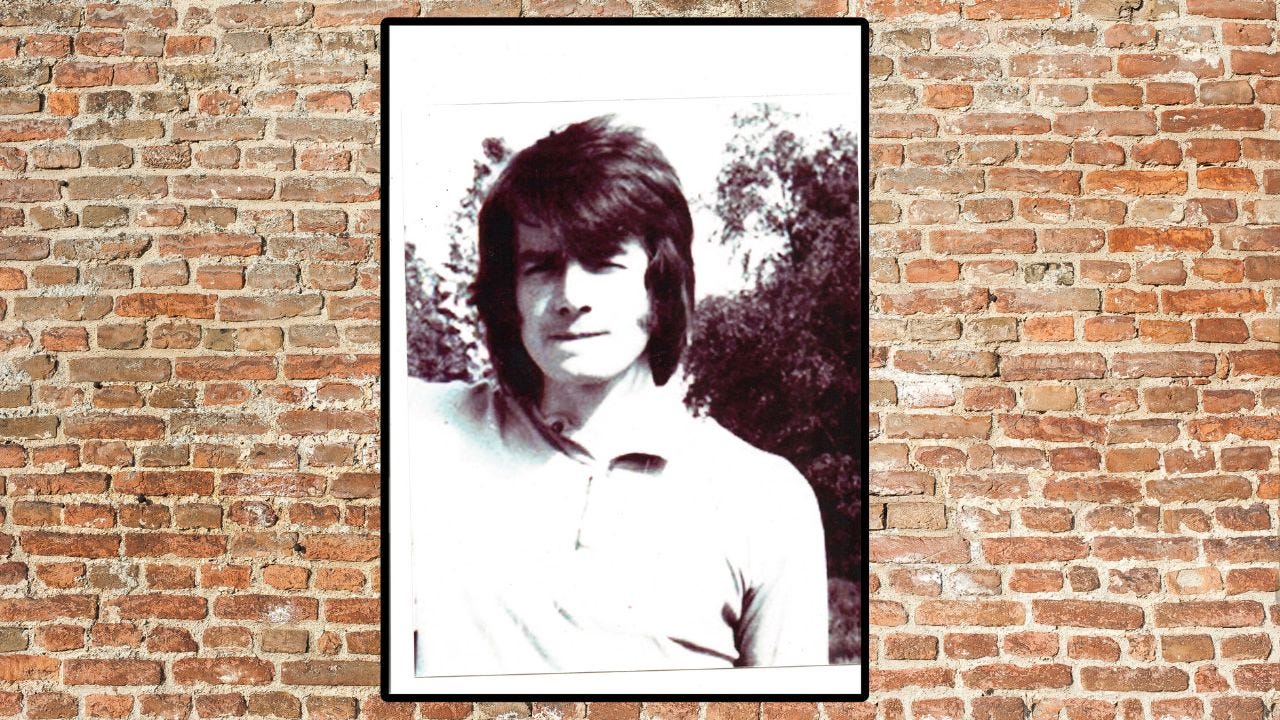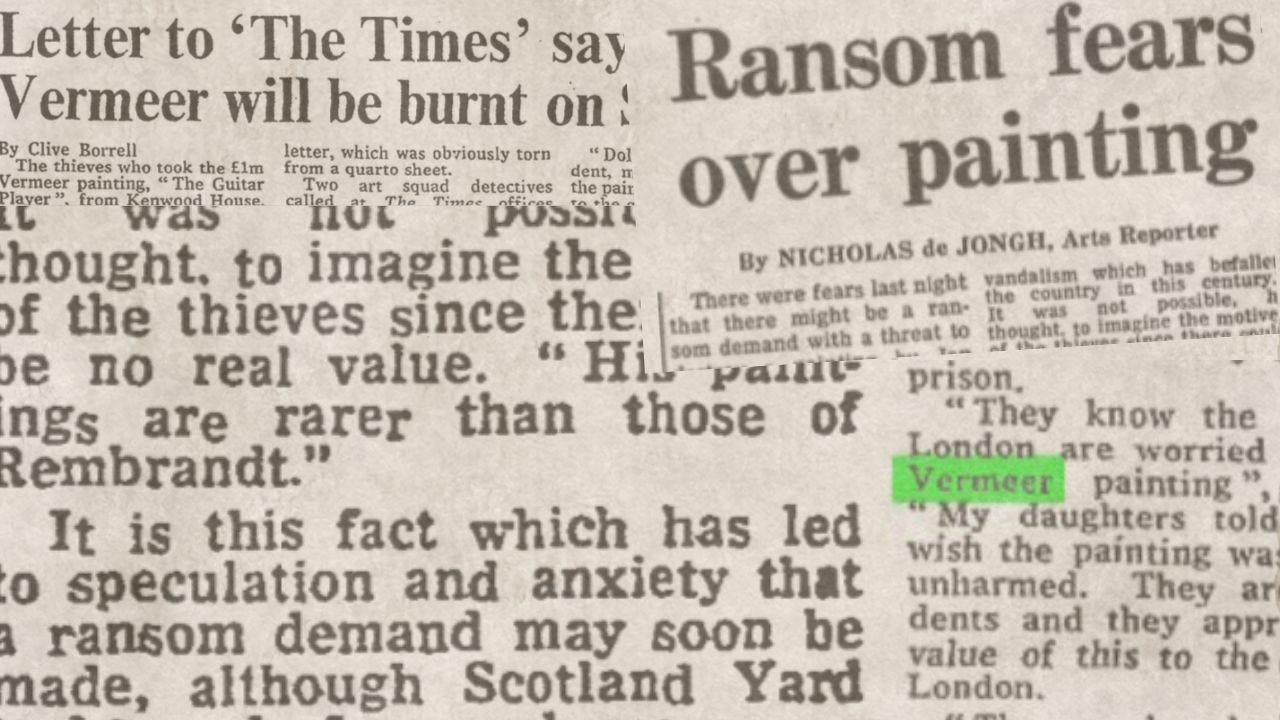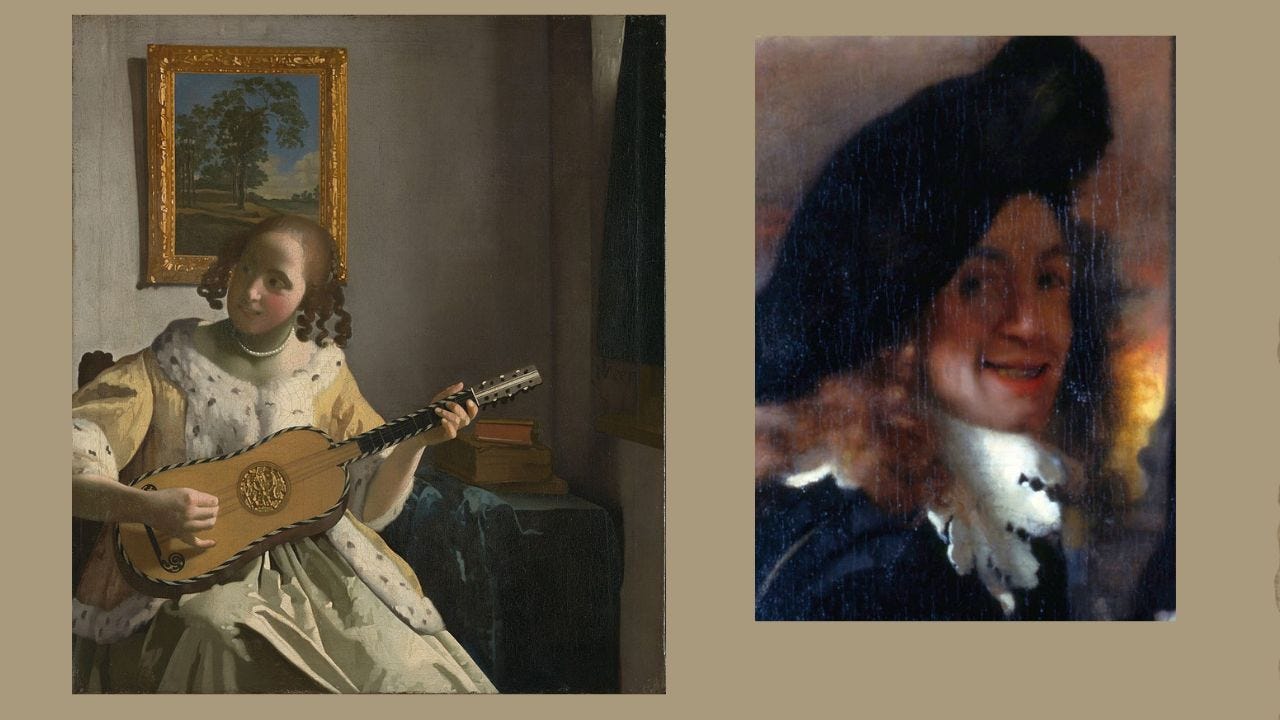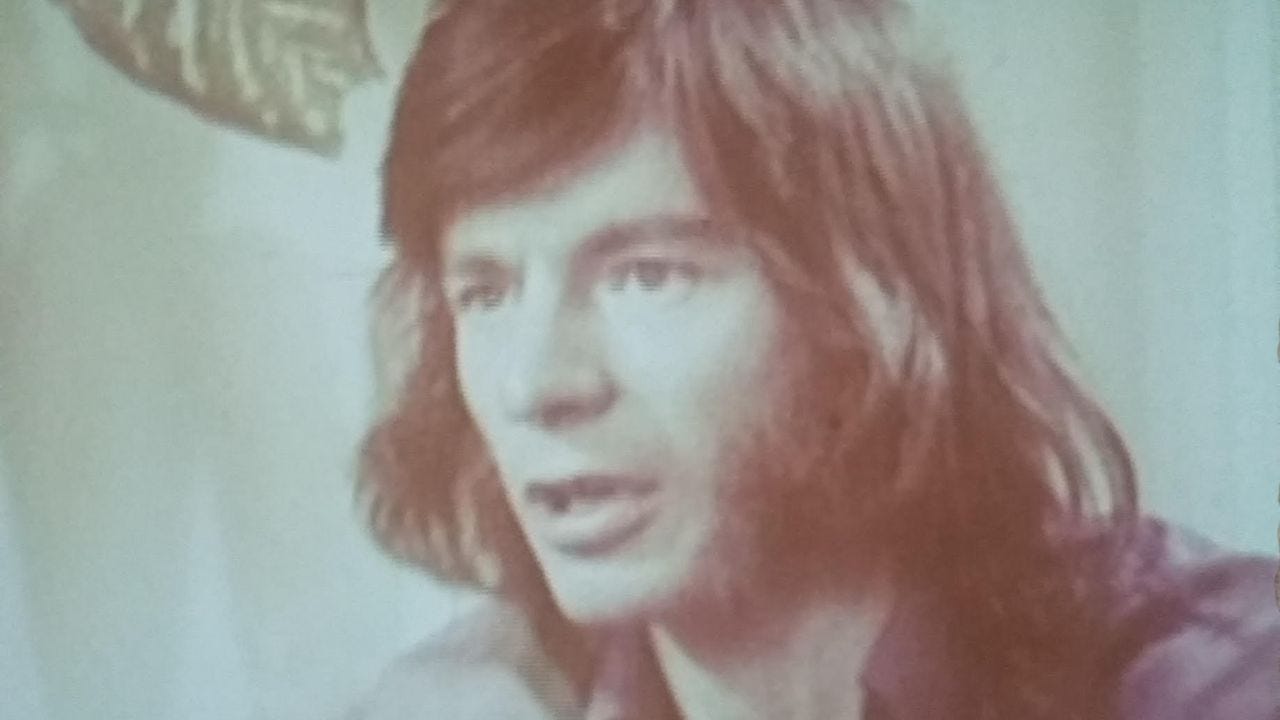'Master thief or madman' The window cleaner who 'kidnapped' a Vermeer
Nephew says his uncle stole priceless painting from Kenwood – but was wrongly convicted for diamond heist
We’re going to get straight into this weekend's feature as it’s a crime caper which reads like a movie script – revealing what really happened when a Vermeer was stolen from Kenwood House in the 1970s. It’s a story in two acts, however – so read to the end to find a psychic sleuth, missing diamonds, corrupt detectives, a letter from David Niven and a prank on Penthouse magazine. There’s a lot for Tom Foot to pack in. Do subscribe if you haven’t already.

UNDER the cover of darkness, a figure slipped into the burial ground at St Bartholomew-the-Great in Smithfield with one of art history’s most revered paintings under his arm.
He rested The Guitar Player, a bewitching classic by the Dutch master Johannes Vermeer forever considered ‘priceless’, against a row of gravestones and quickly disappeared.
Police were tipped off to the location, a discreet choice once city workers had headed home for the day, and so ended a bizarre ten-week ‘kidnapping’ of the painting which unfolded in London at the beginning of 1974.
Vermeer’s life and work are a riddle in itself, the 17th century artist left a trail of enduring questions about his techniques and the meaning behind his captivating pieces.
But so too has been the identity of the thief that stole The Guitar Player from a wall at Kenwood House next to Hampstead Heath.
Until now, at least.
The nephew of the man who had led the desperate detectives from Scotland Yard on a merry dance has told how he will help to join the dots with a new drama.
Paul Hodgson told NewJournal+ that his uncle David Knight, a window cleaner, had regularly told his family how he had been the one who had pinched the Vermeer and eventually agreed a deal to return it at the secret spot.
“The Vermeer was obviously the biggest thing he ever took,” said Mr Hodgson.
“David told me all about it several times, when I was young and when I was older.
“It was by a window on the ground floor and he just smashed that, cut the phone wires so they couldn’t call the police, reached in and got it.
“And then he went off down the hill.”
Mr Hodgson added: “It was worth a lot of money, but the problem with priceless paintings is that they are so famous they cannot be sold. It’s like they’re worthless – so he thought he’d have some fun with it.”
And so Mr Knight, who died in 2009, watched on as outlandish speculation began over who would have taken the treasured artwork and why.
The newspaper clippings from the time show the finger being pointed at IRA terrorists, and then black rights activist groups in Grenada – but the real culprit was British born and bred.
“One of the best parts of it is how the police panicked,” Mr Hodgson said.
“Normally they would just pick up any old ‘Herbert’, some patsy, and that would be that.
“But with this they had to find the painting too. They got a psychic medium involved in the investigation, who helped them find the frame but then led them on a wild-goose chase.
“The police are a bit embarrassed to say that they did this, but there are many examples of them using psychics in their investigations.”
The clairvoyant here was Nella Jones, who whether you believe in such talents or not, provided a tip that led them to finding the painting’s frame in the picturesque lake at Kenwood.
She insisted the location had come to her while watching a report on TV, and had immediately sketched out a map.
Ms Jones – known in the press as “witchie-poo” – went on to form a lasting relationship with the Met and would spend 20 years aiding them in investigations of murders and other serious offences.
Security had been tightened at Kenwood following the theft of another of the artist’s works two years earlier from an exhibition in Brussels and there was an alert telephone line which went straight to police.
But the wires had been cut on the night of February 23, 1974.
"We are looking for either a master thief or a madman," said a spokesman for Scotland Yard at the time.
"It could be the work of someone who does not know what he has done or has no idea of the value of what he has got – but so far we think it is a master thief who has planned the operation over a number of years.”
The Guitar Player had been valued at up to $4.5million – but art historians had described it as “priceless due to its immense artistic importance”.
Experts have squabbled for years over Vermeer’s style with many believing he used a ‘camera obscura’ – a technique used in the 17th century – to project precise images onto a canvas.
In 2022, the Camden New Journal reported on an amazing discovery by the curators at Kenwood who found new details in The Guitar Player which had never before been seen.
At that time electricians came in to install new lamps at the mansion house and the painting was removed from behind a pane of glass which has protected it for decades and given a clean.
But as staff looked at it using candlelight – as Vermeer would have expected it to have been seen – they were thrilled to find traces of pearls around the woman’s neck.
And a fingerprint, believed to be the artist’s.
It is often suggested that the girl in the painting is Vermeer’s daughter.
It had originally been donated to the Greater London Council by Lord Iveagh, a member of the Guinness family.
The archives show how Illtyd Harrington, the then deputy leader of the Greater London Council, was at the time facing questions about whether the state would pay any ransom demands to get it back.
“I am not offering half a million to anybody,” said Mr Harrington, who for clarity we should declare later became our paper’s colourful books editor.
“We haven’t got it, we are operating on a shoe-string. We are not being blackmailed into any situation at all.”
If you look at the small and less than illuminating Wikipedia entry for the theft, it simply says “someone” stole the painting, although, like other mentions of the missing Vermeer case, the prospect of a political ransom is raised.
Amid the confusion and a shoal of red herrings, there was a threat to burn the painting unless food aid was sent to people struggling in Grenada, an island in the Caribbean, and a suggestion that Irish sympathisers were behind the theft as a lever to secure the release of the two high profile prisoners, the “Price Sisters” – Dolores and Marian. Their family said they had nothing to do with it and issued an appeal for the painting to be returned.
The authorities believed the IRA’s Rose Dugdale was responsible for stealing The Guitar Player, but never charged her.
Instead, Mr Knight is believed to have cut a deal with the police to return the painting in exchange for a suspended sentence after being charged with a separate, much smaller crime – leading to the movie-like drop off in the graveyard.
But there is much more to his story.
While Mr Knight would freely admit to the ‘kidnapping’ of the painting to his family, he became better known as somebody who spent a lifetime protesting his innocence for a crime he always told them he didn’t do.
Nearly ten years earlier, he had been convicted of stealing one of the world’s most valuable diamonds, but the prosecution is now widely seen as a miscarriage of justice.
In 1965, the ‘Colenso Diamond’ vanished from under the noses of security guards at the Natural History Museum in South Kensington.
A special report by ITV’s World in Action at the time investigated how Mr Knight – who had a relative living close to the museum – was convicted of stealing it based solely on a “verbal confession” claimed to have been made by two police officers.
It explained why it was “impossible for the jury to find that Mr Knight was not guilty without implying that the police officers were lying”.
Although the 133 carat diamond, donated to the museum by poet John Ruskin, was never found, Mr Knight spent three years in prison protesting his innocence.
Speaking to ITV, Mr Knight said: “I didn’t steal the diamond, and that’s all there is to it. Just give me a chance to get up in a court of law and say what really happened [with the confession].”
The World in Action programme exposed how the two detectives who testified against him, claiming he had confessed to them, were later themselves jailed on charges of corruption and conspiracy to make false allegations.
Speaking about his research into his uncle’s life, Mr Hodgson said: “The judge basically says to the jury, 'do you trust a window cleaner or the police?' David served the time. He never got a pardon, an appeal and the conviction never got quashed.
“But the conviction essentially was a precedent in British law - someone being found guilty on a false confession.
“The trouble was that at that point, David was a criminal – but our conceit is that he went into prison as a window cleaner who had done some petty crimes, and came out with the skills to do much bigger jobs: crack safes and take down fences etcetera. And so he went on the tear from the moment he got out.”
So, while Mr Knight went on to admit to many things – much of which were inspired by people he met in prison – the one he is best known for is the one he went to his grave denying ever doing.
This almost bittersweet story has been meticulously researched over several years by Mr Hodgson, working with his documentary filmmaker friend, Richard Carroll.
“I think overall David’s story is about the conspiracy,” said Mr Hodgson.
“Someone relatively innocent can have their lives turned upside down. How people from working class backgrounds – or black, or disadvantaged in any way – how impossible it was to push back against all of that.”
But he added: “Even as a factual doc, we thought we wanted this to be funny. These stories are funny. No one gets hurt. It’s almost like Bertie Wooster doing these things.”
Mr Knight, born in Fulham, lived for a while in Uxbridge with Mr Hodgson’s family.
“I was about ten at the time and he would tell all these funny stories,” he said.
“As he got older they got more graphic I guess. You’d think some were lies, and then you’d do a bit of research and you were ‘like oh right those pistols were stolen there after all….’
“He’d talk about the poets Shelley and Byron. William Blake was his favourite. He liked the romantic aspect, and the poetry itself.
“Richard and I both work in advertising. Some of the things David did… It makes you think, well you could have got a job in advertising. That kind of deceptive creativity would have been rewarded.
“For example, he used to have an old English sheepdog that he would walk around Knightsbridge areas to scope out places, and had a black cab as a getaway car.”
Mr Hodgson added: “I think he was perpetually in a state of excitement and wonder. I remember him coming home from school one day and the 20p had just been minted. He was there scouring the Queen’s face off one side. I was like ‘what are you doing?’ And he was saying, ‘well I just don’t like that side’.
“He was always in that state of doing something. Later he would be endlessly writing letters to people, signed by Lord Percy, who was his hamster.”
Mr Carroll told a story about Mr Knight breaking into the Penthouse Magazine’s building in the West End, stealing the company’s mailing list ‘Rolodex’, and sending out requests for £10 postal orders for “dirty books” that didn’t exist.
There were other outrageous stunts at Harvey Nichols in Knightsbridge along with the "kidnap" of the Vermeer masterpiece.
Mr Carroll said he had enjoyed reading the responses to Mr Knight’s many letters during his research, sent out after his mind started to wobble in later life.
He said: “David Niven wrote back to him – there’s a lovely letter from him - who was in the films obviously on the trail of the diamond thief in The Pink Panther. We don’t know what David wrote to him, but we got the letter back that says: ‘Dear David, sounds awful. Must dash. I’ve got one foot on a banana skin, the other on a Concorde. Signed David Niven.”
Another wrote back saying: ‘We’d just like you to know that there is a madman using your address.’ Which is a really good response to anyone I think.”
Dick Clement and Ian La Frenais, the writers of Porridge and The Likely Lads now living in LA, have got involved in writing the project after meeting Mr Carroll at a dinner party.
Mr Carroll said: “There were lots of characters at the party and I got talking to Ian about his work, and we decided to keep in touch. He kept asking more and more about what we thought at the time was going to be a doc. He kept saying it’s a three part drama, not a documentary - and of course he was right.”
The first episode has been written by Mr Le Frenais, whose other works include classics TV series like Auf Wiedersehen Pet.
The first episode has been written and full treatment created for the series, Rough Diamond. The project is still in the process of getting fully financed and a podcast about the story is also coming out soon.
More details can be found at https://colensofilms.com/
Look out for our politics column, the North London Bubble, out tomorrow and our Monday digest of news at the start of the week. If you haven’t already done so, please do consider upgrading to a paid subscription of NewJournal+ – every penny we receive goes into covering the costs of the work we do.








